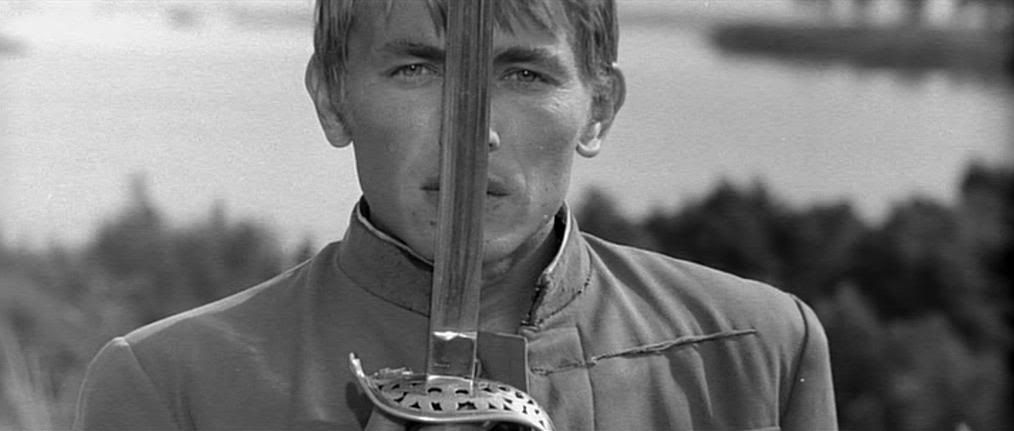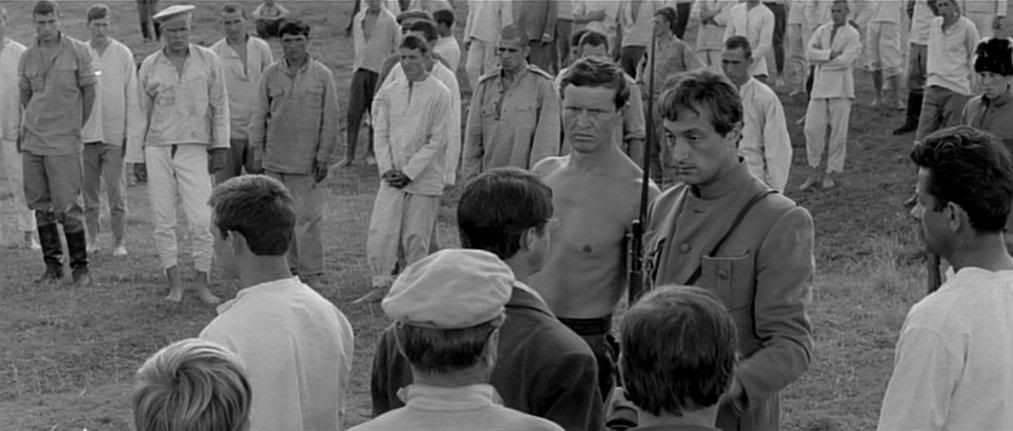
Whoever says, with François Truffaut, that there's no such thing as a true anti-war film, has clearly never seen Miklós Jancsó's The Red and the White, a brilliant, harrowing war film that never even remotely falls into the familiar trap of glorifying war in the process of critiquing it. Set in 1919, in the aftermath of the Bolshevik Revolution, the film depicts a series of skirmishes between Hungarian Communists, aiding the Bolsheviks, and the remnants of the Tsarist White Russian troops. These specific politics are hardly relevant to the film, however, because Jancsó seems far more interested in war as an abstract, in the absurdity and wastefulness of war. The film doesn't have a central presence, a protagonist or protagonists who the camera follows through their adventures; Jancsó doesn't even remain with one side or the other, instead fluidly shifting from one potential protagonist to the next, hardly even bothering to keep straight who's on which side as a series of bizarre, almost surreal vignettes create an atmosphere of confusion and pointlessness.
Jancsó's camera tracks smoothly across stark widescreen vistas, its movements suggesting the fluid way in which fortunes are reversed in the chaos of battle. The soldiers on both sides alternately charge and retreat, take prisoners and are taken prisoner, as the camera tracks this way and that. Prisoners are ordered to and fro, ordered to strip, to run, to line up, to line up again somewhere else. Some are killed, some are forced into games of sport, subject to the whims of sadistic commanders, others are stripped and told that they can leave; sometimes they're genuinely set free, and other times supposed freedom just leads into another game, another trap. There's no logic to all this, only the absurd rigor of military discipline, constantly arranging people into abstract groups, regimenting their lives and their deaths. People are picked at random to live or to die, most of them seemingly dying not in the heat of battle — which is rare and brief — but when they're toyed with, in post-battle boredom, by the victors.
Every victory is momentary, too, as Jancsó keeps underlining by constantly shifting from one side to the other. Sometimes the Reds seem to be winning, taking the White soldiers prisoner, but it's seldom long before more Whites will show up to turn the tide of battle yet again. To the people of the countryside, it hardly matters who's ascendant at any given moment, because no matter which side is dominant, the innocent civilians are subject to constant searches and harassment, the women always threatened with rape and assault, their only hope that there will be a stray honorable officer here and there among the troops.
Jancsó captures the fragmentation and absurdity of war in every moment of his film, alternating between long periods of stasis and confused bursts of violence in which it's seldom clear which side is which or who's winning. The countryside in which these battles are taking place seems largely empty, with big open fields dotted with farms and small wooden homes. The wide frame de-emphasizes any individuals: there are very few characters who survive more than a few minutes onscreen, and even when one of the soldiers momentarily steps into the foreground of the frame for an ad-hoc closeup, inevitably he's dead or melted back into the general clamor a few moments later. The closest the film comes to a conventional narrative is when Jancsó lingers for a somewhat longer stretch at a small hospital where a group of nurses shelter some fleeing Communists, refusing to divulge to the White soldiers who's who among the patients. One of the nurses (Tatyana Konyukhova) defiantly tells the commander, "there are no Reds or Whites here, only patients," a bold and rare expression of honor amidst all this vile pointlessness. Another nurse (Krystyna Mikolajewska) entertains a fling with one of the Reds — she doesn't need love, she says, seemingly just hungry for any human, sensual connection — but this brief hint of a conventional wartime romantic narrative is abruptly cut short by the arrival of the Whites, the abortive romance extinguished in the cruelest possible way, with Jancsó's camera remaining at an aloof distance from the violence, capturing the raw emotion of the moment from a slight remove. (Later, the Reds, oblivious to this cruelty, perpetrate a further injustice on the same woman.)

The war's absurdity is memorably captured in a surreal sequence where the Whites round up a group of nurses and bring them to a clearing in a nearby forest. The threat of violence hangs over the scene, but instead of shooting or raping the women, the soldiers bring out a band and order the women to dance together in the clearing, wearing fancy dresses provided by the soldiers, until finally sending them all home unharmed. There's no sense here, only inexplicable events and actions, outlandish expressions of war's total ridiculousness. Towards the end of the film, a group of Red soldiers strip off their uniforms and march, singing, towards a superior force of White soldiers, arrayed like human dominoes in neat rows on the field below. The men below remain static, allowing the charging enemy to pick off some of their number, the dead men falling and leaving gaps in the neat structure of the front line, before finally the surviving dominoes mow down all the approaching soldiers with a barrage of rifle fire. Jancsó observes this pointless exchange of deaths from above, peering down the hill from a distance so that the individual men are nothing but abstract shapes, identified only by the colors of their uniforms, part of a human formation, a human machine in which the individual parts are always expendable.
That shot, in which the opposing formations are clearly visible in relation to one another, is an exception here. Jancsó's framing often accentuates the confusion of war by shooting battle scenes so that the two sides are not in the same frame, and death enters unexpectedly from offscreen. The camera will often focus momentarily on a soldier only to have him suddenly die, with the opposing troops then entering from offscreen, the camera tracking over to accomodate the shift in perspective from one side to the other. There's no logic here, no strategy, and battles are often over as soon as they've begun, with one side being taken by surprise and slaughtered by the other, often while in the middle of the seemingly endless process of sorting out prisoners and enacting punishments and vengeance. The soldiers spend more time with that kind of administration than they do fighting. Both sides are constantly sorting out Hungarians from Russians, trying to identify who belongs to which nationality within the prisoners, but there's no consistency in how the two groups are treated, and the prisoners can't be sure if it's a death sentence to identify as Russian, as Hungarian, or, as often seems to be the case, if it doesn't really matter and they'll all be dying one way or another. In one early scene, the Whites sort out their prisoners in this way and then send the Hungarians home, which prompts one Hungarian who hadn't identified himself — presumably afraid of what it would mean to speak up — to belatedly come forward. By then, the Whites don't care, they tell him it's too late and herd him in with the Russian prisoners, who are then sent off to a cruel game that turns into a manhunt.
There's a clear sense here that these divisions — Red or White, Russian or Hungarian, citizen or soldier — are ultimately arbitrary and meaningless, as everyone is chewed up by the cruel anti-logic of the war. That's what makes The Red and the White such a bold war film, such a powerful statement. It's not tied to any ideology or any particular war, instead depicting the nonsensical wasteland into which war inevitably transforms any landscape, grinding up anyone in its path. The film follows the trail of death and destruction from one man to the next, allowing each man in turn to be the victor and the loser, the tormenter and the victim, the killer and the killed. Only rarely in all this is there any sense of right and wrong, of anyone able to maintain a strong moral center in the face of the absurdity and randomness that is war.

3 comments:
I'll never forget when Jansco'sThe Round-Up was screened at the New York Film Festival in 1966. At the end the Hungarian National Anthem is sung and every Hungarian in the audience stood up and sang along.
Winter, Wind, Silence and Cry, The Confrontation and The Pascifist are some of his other equally impressive works from this period. In recent years he has switched to porn.
"These specific politics are hardly relevant to the film, however, because Jancsó seems far more interested in war as an abstract, in the absurdity and wastefulness of war. The film doesn't have a central presence, a protagonist or protagonists who the camera follows through their adventures; Jancsó doesn't even remain with one side or the other, instead fluidly shifting from one potential protagonist to the next, hardly even bothering to keep straight who's on which side as a series of bizarre, almost surreal vignettes create an atmosphere of confusion and pointlessness."
David has beat me to the punch with THE ROUND-UP, which for me is Jansco's masterpiece, one of the greatest of Hungarian films, and for me the top film of it's early 60's release year. Great anecdote of the Hungarians in the audience!
Ed, I must tip my cap to you. Just when one may think you have raised the bar, you come out with yet another analytical prose masterpiece. You had me hanging with every word, and the above excerpt sums up this masterful war film's intent and artistry. Yep, Jansco's camera is negotiated with magician-like precision, and you pound home with rhetorical gale force the absurdity of war in this landmark work of Hungarian cinema. This is a powerful work.
I remain convinced that the film's protagonist is Nikita Mikhalkov. However, due to contractual disputes his remaining parts were never able to be filmed (switching sides, being taken prisoner, etc.) so they just shot the scenes without him and hoped people would get the idea through the effect created by the imposing void left in his absence. You can replicate the effect by superimposing a sequence of frames over the top of each other and sequentially removing one of them - the only movement created by absence. This may be too abstract a comparison, though, for such a straightforward film. After all, there isn't even any superimposition in the film, if I recall correctly. How utterly conventional. And yet people are still fooled! There's a reason they remade this film as a mainstream action film (Transformers 2). Granted, that one is a bit of a masterpiece of experimental cinema, but Bay can't be blamed for infusing the original concept with his own talents. At the end of the day, it's a shame people are so taken with a blunder like this when there's a fully realized version available. Who cares about Miklos Jancso. The man makes only one film, for Christ's sake. Have you seen My Way Home? It's the same film! Doesn't anybody notice this? I feel like I'm taking crazy pills!
Post a Comment